Ready to step back in time to ancient Greece? This guide is your ticket to exploring the incredible Ancient Greek cities where legends of gods, goddesses, and mythical heroes were born. We’re covering top spots like Athens and the Peloponnese, plus hidden gems in northern Greece and the enchanting Greek Islands.
Think awe-inspiring Greek temples, tales etched in ruins, and landscapes straight out of Greek mythology. Whether it’s in bustling Athens or the serene mainland, each place tells a story of the ancient Greeks. Get set to immerse yourself in history and myth – this journey through ancient Greece is one you won’t forget.
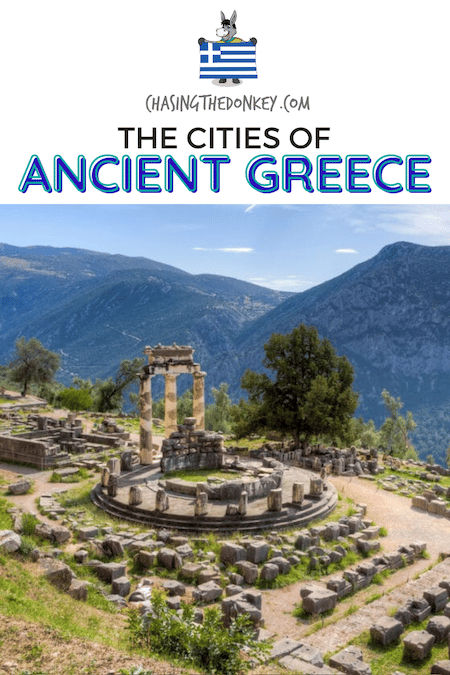
Let’s dive into the past and explore these timeless wonders!
Skip Ahead To My Advice Here!
Ancient City Of Athens
Athens was first settled in 3000 BC, on the Acropolis rock, and by 1400 BC, Athens had become a major center of Mycenaean civilization. The Mycenaean city-state was officially founded by King Theseus, who united many Attica settlements and ruled until the 9th century BC.
Athens was known for its trade and naval prowess, becoming the center of Greek civilization and the birthplace of democracy.
1. Acropolis Of Athens & Athenian Agora

When settled in 3000 BC, the city of Athens was positioned on Acropolis rock, where, as time went on, the great Mycenaean fortress was built.
Today, the magnificent Acropolis Hill and its countless historical ruins can be explored. The main attractions on any trip to the Acropolis include famous Greek cities such as the Parthenon, the Erechtheion, the Propylaia, the Temple of Athena, Herodotus’ Odeum, and the Theater of Dionysus. In actuality, they are among the most significant tourist attractions on Greece’s mainland.
You must visit the Acropolis Museum while in this ancient Greek city. This spectacular new structure, which is entirely unlike the grungy ancient remains on the Acropolis, contains separate rooms for the main Acropolis buildings and exhibits the treasures found inside. In the Trip Anthropologist audio series about Ancient Greece, you may hear all about the main mythology of the gods and goddesses of the Acropolis, as well as about many other Greek structures.
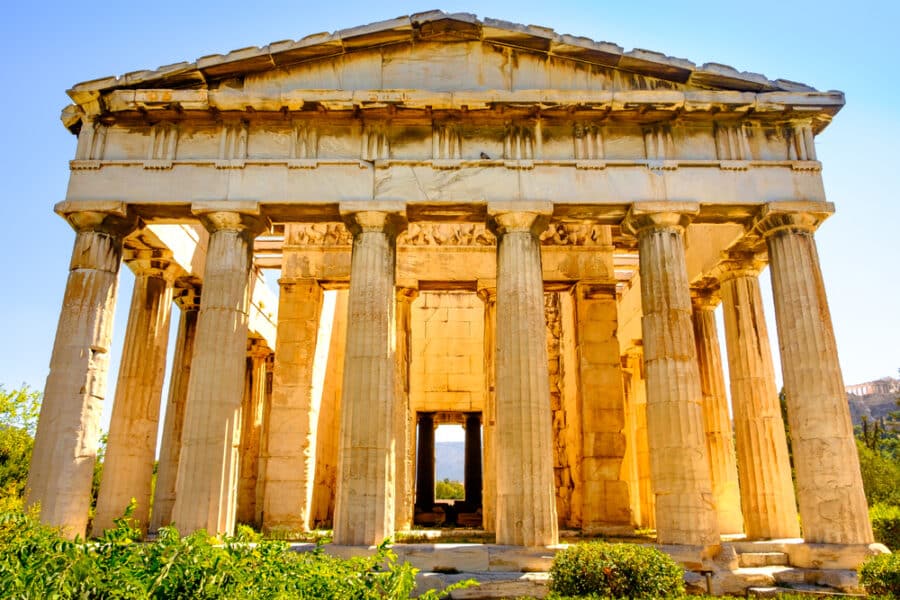
The ancient Agora in Athens, which is situated just below the Acropolis, is arguably the second-most well-known archaeological site in all of Greece. This group of ruins essentially represents an “agora,” a gathering place or marketplace in Greek. The Agora, in the city’s center, has seen numerous additions and demolitions over its approximately 5,000-year history.
Today, archaeologists are working to uncover more information about the location in relation to ancient Athens. Visitors can take in the restored Stoa of Attalos, a long colonnaded structure that stretches along the site’s edge, and discover more about the well-preserved Temple of Hephaestus.
Ancient Cities Of The Peloponnese Region
2. Sparta

Sparta was a sizable old Greek city-state and Athens’ primary adversary in ancient Greece. Its military might was its greatest asset. Sparta’s valiant troops served their city. Every adult male was assigned to a slave-run farm and considered a soldier in the Spartan army, which was small.
Starting as a small polis with only five towns, it expanded by annexing other settlements and states, eventually devouring the majority of the Peloponnese and enslaving many of its citizens.
It had enormous authority and was in charge of a huge area by 650 BC. A warrior class controlled its populace. Only via military alliances created amongst other important Greek city-states, such as Argos, Athens, Corinth, and Thebes, could Sparta be subdued. At the Battle of Mantinea in 362 BC, it ultimately fell to Thebes.
Temples, columns, a theater from the Hellenistic era, and a statue of Leonidas, the Spartan general who commanded Greece in its defense of Thermopylae against Persia’s Xerxes I, can currently be found among Sparta’s ruins.
3. Olympia
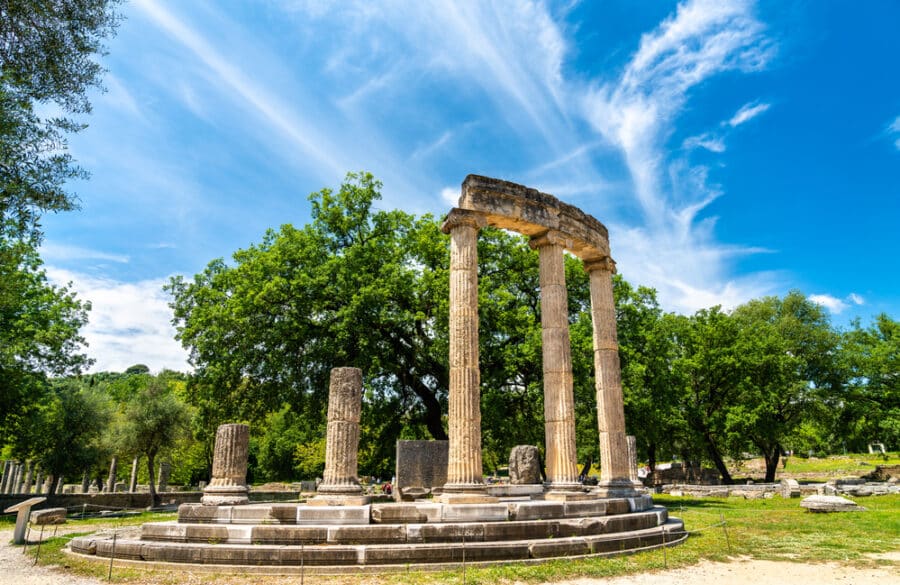
One of the most critical sanctuaries in ancient times, devoted to worshiping the most important of all Greek gods, Zeus, Olympia is located in the heart of the Peloponnese. She is one of the Greek sites loved by children.
Also, the Olympic Games would take place in Ancient Olympia. The games were first held during the 7th century BC, and they were organized to honor the great Greek gods. Known to have been the most remarkable sports competition, even wars, and battles would come to a stop for the Olympic Games to take place.
When you visit, don’t miss the Temple of Zeus and Hera, the workshop of sculptor Phidias, and the area where the sports and games took place. The Museum of Olympia is another fantastic visit to add to your itinerary.
In the heart of Ancient Olympia, ideal for families with kids, Hotel Hercules combines a friendly atmosphere and great-value accommodation. If you prefer to rent a villa and explore the Peloponnese, check out the fantastic facilities of Bacchus, a traditional stone mansion with beautiful views of the surrounding area, just 3 kilometers away from Ancient Olympia.
4. Corinth
One of the biggest and most significant ancient Greek civilizations was Corinth. The once massive city was established at the base of Acrocorinth, a rock over 500 meters long, with city walls stretching from Acrocorinth to a harbor in the Gulf of Corinth. Today, the city bears the historical imprint of the Byzantines, the Venetians, the Ottomans, and the pirates.
The Corinth Canal, which links the Saronic Gulf and the Ionian Sea, may be seen in present-day Corinth. You can see this technical marvel, which has turned the ancient Peloponnese peninsula into yet another breathtaking Greek “island” from above as you cross the artificial Corinth canal.
Remember to stop by the important Temple of Apollo, constructed around 560 BC and located just beneath Acrocorinth, the Corinthian Acropolis.
5. Mycenae
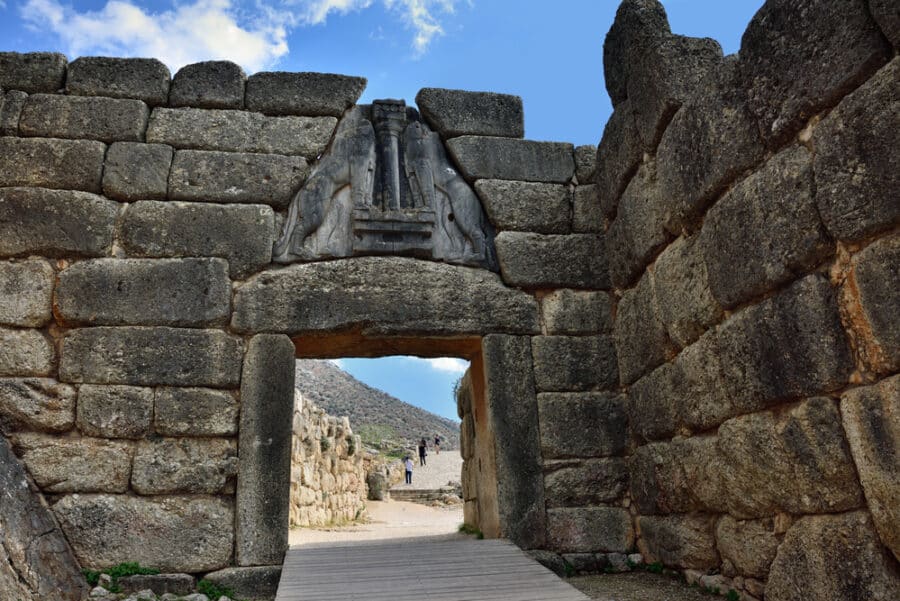
Like Corinth, Mycenae was once a thriving city-state and a prosperous trade hub. Nestled among the rolling hills of the Peloponnese, this ancient city salutes the visitors with all its might and offers them a perspective of a long-gone time.
Mycenae was an important center of power during the Bronze Age and was ruled by various civilizations throughout history.
Nevertheless, today, the city’s prosperous days are behind it. The well-preserved ruins, including the impressive Lion Gate, the palace complex, and the Cyclopean walls, give the visitors a feeling of pride and longing.
6. Epidauus
Brands We Use And Trust
Epidaurus was a small city endowed with a moderate climate, fertile soil, and several natural springs. It was one of the most famous ancient Greek cities for the exquisite acoustics of its well-preserved theater. The Temple of Asclepius, a deity renowned for his exceptional healing abilities, was located inside the city.
As a result, pilgrims came to Epidaurus from all around with dedications that helped pay for countless building and artistic endeavors. The theatre is in good condition and arguably the most popular place to see when in Epidaurus. The ruin is an interesting spot to visit because of the acoustics, which allows visitors to hear clearly from wherever in the stands. Epidaurus’ theater is still utilized today for summertime productions and live music concerts.
7. Argos
This city has a continuous history of settlement from ancient times to the present day. It is located in the Peloponnese region of Greece.
Ancient Kingdom Of Macedonia
8. Pella & Vergina
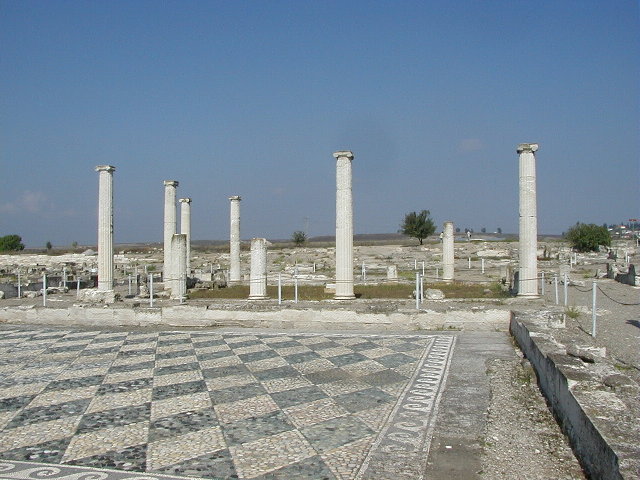
The Ancient Greek Kingdom of Macedonia rose to power during the 4th century BC under the rule of Philip II. You most likely have heard of his son, Alexander the Great, who rolled out the Hellenistic period of Greece when he set out to conquer the world.
The city of Pella, the birthplace of Alexander the Great, is about 45 minutes from Thessaloniki.
Once in town, take some time to explore the local museum and the archaeological site of Pella, home to some stunning mosaics and objects from different periods.
While in the area, add a second stop to your trip by heading to Vergina. Here, it is possible to visit the Museum of the Royal Tombs of Aigai and the Archaeological sites exhibiting excavations and objects belonging to the splendorous Greek Kingdom of Macedonia.
Tip: Vergina is home to one of the most important breweries in Greece, so why not head here for a visit and a session of local beer tasting?
Ancient Cities Of Central Greece
9. Delphi
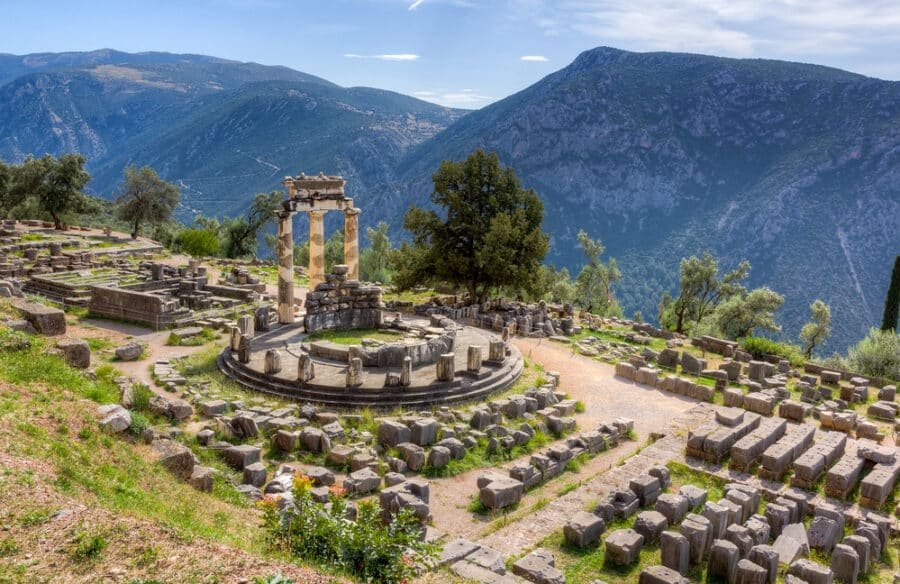
Delphi used to be a popular destination for pilgrims thousands of years ago. This was due to the fact that the Apollo Sanctuary in this region was home to one of the most significant oracles in all of Greece. Because of her capacity to communicate with the Greek deity Apollo, the oracle (also known as Pythia) was a valued female member of ancient Greek society. People would come to Delphi from all over the world and from all various eras to consult the oracle. Delphi became one of the major cities in ancient Greece because of her presence.
The Pythian games, which were place in Delphi every four years, were also held there. Participants from all over ancient Greece competed in equestrian and athletic competitions for a laurel crown carved from the sacred Apollo tree.
Nowadays, the mountain town of Delphi is frequented by travelers rather than pilgrims. The restaurants perched on cliffs that overlook the lavish olive groves are just one of the many reasons to visit.
10. Thebes
Thebes, which was established 48 kilometers northwest of Athens at the foot of the Teumessus mountain, eventually became the largest city in that area. It is famously known as the home of Hercules and as a rival of Athens.
Despite the fact that historians of old could not agree on their names, its seven gates were renowned. Among them were Neista, Pretida, Ogigia, Homoloid, Crenea, Electra, and the unknown Seventh Gate, according to Euripides.
Contemporary historians believe Thebes’ population was Pelasgian and not Phoenician in origin. Some claim that Thebes was a Crete colony and that the alphabet was the only thing the Phoenicians contributed.
Ancient Cities Of The Islands
11. Knossos, Crete Island
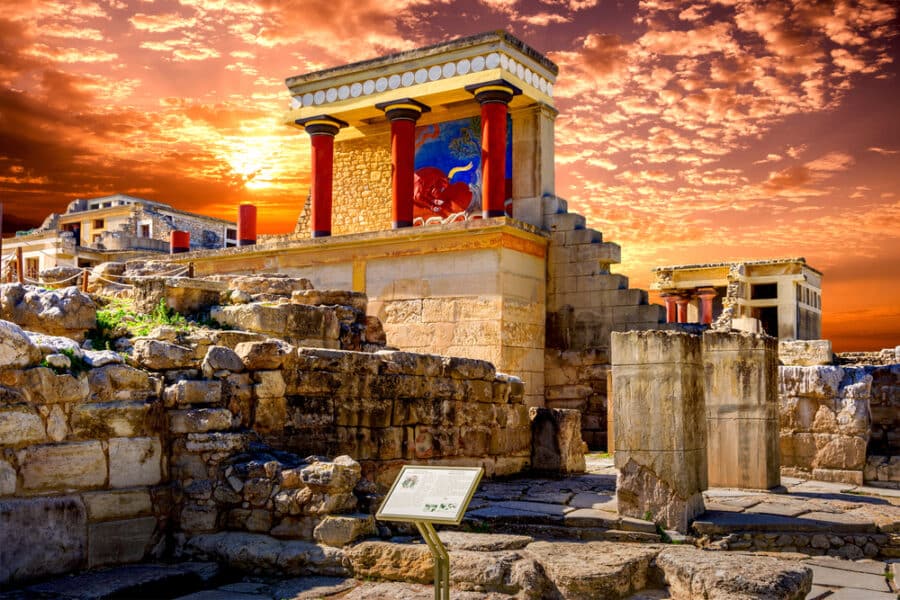
The largest archaeological site in Crete is located at Knossos, the Minoan civilization’s capital. It contains the remnants of a huge palace that once stood where the legendary labyrinth from the Theseus and the Minotaur story is said to have been. The Royal Chambers, porticoes, and irrigation drains are among the site’s countless detailed murals and artworks. It is one of the most ancient and famous Greek places.
12. Akrotiri, Santorini Island
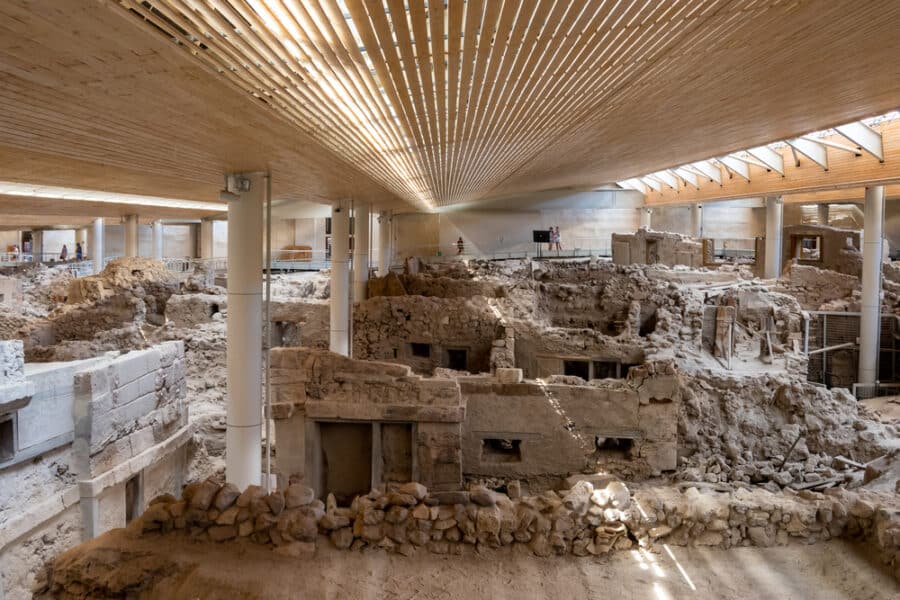
The world-famous sunsets and romantic restaurants draw most visitors to the island of Santorini, but the vacation island is also where the Bronze Age village of Akrotiri once stood. It was a significant Minoan port city that was blanketed in volcanic ash in the 17th century BC, and excavations started there in 1867. It is now known as the Greek Pompei, and excavations there are still going on today despite discovering several riches there, including frescoes, structures, and artifacts.
13. Eretria, Evia (Euboea) Island
Located about 20 km south of Chalkis, the capital of Evia Island, you can explore the ancient ruins of Eretria, with remains dating back to the ninth century BC. The city was once an important city-state, and Homer mentions ships from Eretria participated in the Trojan War.
Among the ruins you can see today, there are two remarkable palaces, ancient baths, important temples, and a private residence with unique mosaics.
However, the most essential feature on the site is the ancient theater, among the oldest ones in Greece, dating back to the fifth century BC. The most curious characteristic of the amphitheater is that it was laid on an artificial hill.
After exploring the ancient site, it’s a good idea to head to the Archaeological Museum of Eretria, which features figurines, vases, and other relics found in the ancient site, such as a remarkable funerary amphora depicting Heracles fighting the Centaurs.
The museum is open every day, except Tuesdays, from 8:30 am to 3:30 pm. The entrance fee is 2 euro.
14. Aegina Island

This island, as a whole, was known for its impressive naval fleet in 500 BC. With its location between the three main trade routes of Ancient Greece – Corinth, Peloponnese, and Attica – the island became a wealth of commercial development.
Wondering what to do in Aegina? Probably one of the places you shouldn’t miss when visiting Aegina is the beautiful Temple of Aphaia, considered the best-preserved Classic temple in Greece.
This impressive site dates back to 500 BC. Located about 13 km from Aegina Town, the site is on a hill and offers stunning views of the surrounding area. The entrance fee is 6 euros.
When you visit, why not also spend an hour discovering the fantastic Archaeological Museum of Aphaia? It’s located right in the archaeological site area, and it will depict a wider panorama of life on the island during the Classic times.
15. Samos Island
Of course, Samos is an island we can’t avoid mentioning. The island was a strong maritime city-state and is the birthplace of Pythagoras. A visit to the Pythagoreion and Heraion of Samos is essential to any Greek history tour, especially if you’re a math fan!
The Pythagoreion and Heraion of Samos are two UNESCO archaeological sites on Samos. They are a reminder of the island’s ancient past, with ruins that date back to the 8th century BC. Highlights include the remains of fortifications, temples, palaces, and public buildings. The site is also home to a museum, where visitors can learn more about the island’s rich history and culture.
Ancient Cities Now Part Of Modern-Day Turkiye
16. Ephesus

Although Ephesus is in modern-day Turkey, it was originally an ancient Greek city of enormous importance. The city was founded in the 10th century BC and was later taken control of by the Romans in 129 BC. This is when Ephesus’ time really came to fruition as the city grew, becoming a bustling and massive place with strategic importance close to the Aegean. At its peak, it is thought that around 50,000 people lived in Ephesus.
Much of the architecture you’ll see today was built by the Romans, including the famous Temple of Artemis and the vast Ephesos theater, which is in perfect shape, considering its age! In its heyday, the amphitheater could hold around 25,000 people, and many gladiator battles took place there and drama shows. The Temple of Hadrian and the Library of Celsus were also prominent buildings constructed by the Romans.
The city moved into Ottoman Rule between 1304 and 1425, and during this time, the city slowly declined.
The history of Ephesus is rich and diverse, and there is a lot of religious significance, too. Many important figures in religious history are said to have visited Ephesus, and the House of the Virgin Mary is said to be where the Virgin Mary spent her last days.
17. Byzantium & Constantinople (Istanbul)
Istanbul is a tale of two continents, empires, and millennia. Also known as Byzantium and Constantinople by good ol’ fellows back in the day, Istanbul is one of the most important cities in the history of our era.
Part of the Roman and Byzantine Empires, it wasn’t until the 15th century that it became an Ottoman bastion, adopting the Islamic faith. Divided into two by the Bosphorus strait, Istanbul’s Western side belongs to Europe and the Eastern to Asia.
18. Aphrodisias
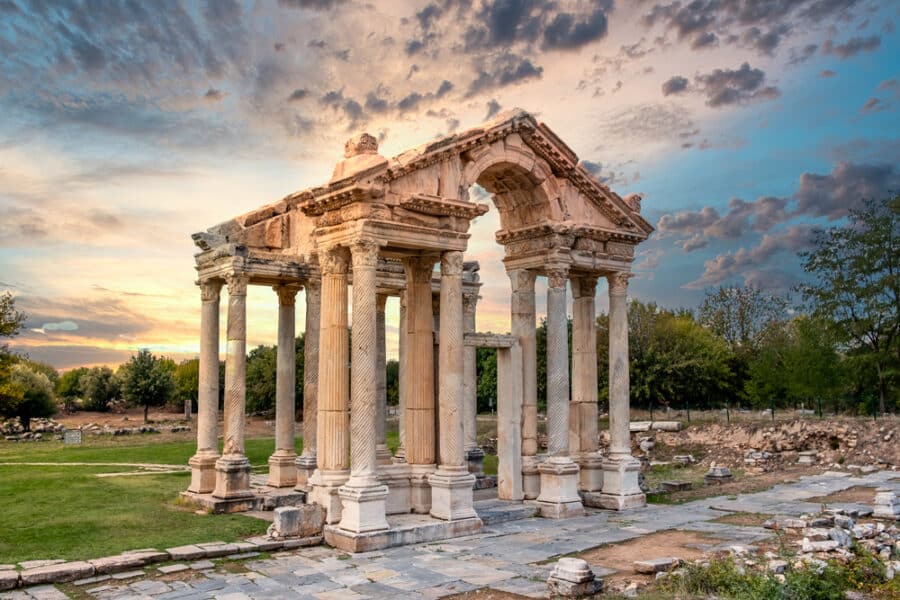
Aphrodisias was an ancient Greek city located in southwestern Turkey. The city was named after the goddess Aphrodite and flourished during the Roman period. Today, the site is a UNESCO World Heritage site and is considered one of the most important archaeological sites in Turkey.
Aphrodisias was built on a plateau overlooking the River Maeander and consisted of two main areas: the Acropolis, which housed the temples and public buildings, and the lower town, which was the commercial and residential center. The most impressive monuments at Aphrodisias include the Temple of Aphrodite, the Tetrapylon (a monumental gateway), the Stadium, and the Theater.
- The Temple of Aphrodite was one of the largest temples in the city and was dedicated to the goddess of love and beauty. The temple was adorned with numerous statues and reliefs depicting Aphrodite and her worshippers.
- Tetrapylon was a four-sided gateway decorated with columns that led into the main street of Aphrodisias. The Stadium was used for athletic competitions and could seat up to 30,000 spectators.
- The theater was used for both theatrical performances and gladiatorial games. It could seat up to 20,000 people in its tiered seats.
Today, visitors can explore the ruins of Aphrodisias and see many of its impressive monuments. The site also has a museum housing artifacts found during excavations at Aphrodisias.
19. Pergamon
In Izmir Province, Pergamon is an archaeological site that sits high up on the hillside. Pergamon was once a powerful Hellenistic colony and was home to an incredible library of scrolls.
The Acropolis of Pergamon was considered the capital of the Hellenistic Attalid, and there are many temples and old ruins to explore. In addition, visitors can explore its well-preserved huge amphitheater and the famous Library of Pergamon.
The Kybele Sanctuary is also part of this site, as well as old burial centers and plenty of evidence that points back to different eras, including Byzantine, Roman, and Ottoman.
- 20. Miletus – a premier fortified city on the western coast of Anatolia
- 21. Halicarnassus – one of the Seven Wonders of the Ancient World, today found in Mugla
- 22. Miletus: this ancient Greek city is now located near the modern town of Balat in Aydın Province, Turkey
- 23. Colophon: An ancient city of Ionia, Colophon is now near the town of Değirmendere Fevzi Çakmak in İzmir Province, Turkey
- 24. Syracuse: Once a powerful Greek city-state, Syracuse is now a historic city in the Italian region of Sicily
- 25. Cyrene: An ancient Greek and later Roman city near present-day Shahhat, Libya
Move This Adventure To Your Inbox & Get An Instant Freebie

No spam. Unsubscribe at any time.
FAQs About Ancient Greece
What were the major contributions of Ancient Greece to human culture?
Ancient Greece made significant contributions to human culture, including philosophy, science, architecture, the Olympic Games, and democracy.
Which were the important cities in Ancient Greece?
Ancient Greece had several important cities, such as Athens, Sparta, Corinth, Pergamon, Olympia, Thebes, Miletus, Syracuse, Byzantium, Cyrene, Argos, Ephesus, Halicarnassus, Knossos, the Kingdom of Macedonia, Samos, Colophon, Aegina, and Eretria.
What was the significance of Athens?
Athens was a major ancient Greek city known for its advancements in agriculture, urbanization, and the development of central banks, coinage, and public places.
What was Sparta known for?
Sparta was a major rival to Athens, with its strength lying in its military power and control over the Peloponnese region.
What was notable about Corinth?
Corinth was a prosperous city known for its shipbuilding industry and the important Doric Temple of Apollo.
What was unique about Pergamon?
Pergamon exercised hegemony over parts of Asia Minor and housed an impressive library with numerous scrolls.
What was the significance of Olympia?
Olympia was a sanctuary dedicated to Zeus and the birthplace of the Olympic Games.
What roles did other cities play in Ancient Greek history?
Various cities such as Thebes, Miletus, Syracuse, Byzantium, Cyrene, Argos, Ephesus, Halicarnassus, Knossos, the Kingdom of Macedonia, Samos, Colophon, Aegina, and Eretria played significant roles in Ancient Greek history and culture.
- Unique Things To Do In Greece With Kids
- How To Tip In Greece
- Car Rental And Driving Tips For Greece
- Where To Stay In Crete
- What To Expect & Do In September In Greece
- Things To Do In Greece During The Winter
- Packing Tips For Greece
- Things To Do And Eat During Easter In Greece
- How To Travel Greece On A Budget
- How To Get From Santorini To Crete
- Things To Do In Corfu For Families
- Best Cave Hotels In Greece
- Where To Stay On Corfu
- Greek Island Groups – Everything You Need To Know
- Mainland Beaches In Greece Not To Miss


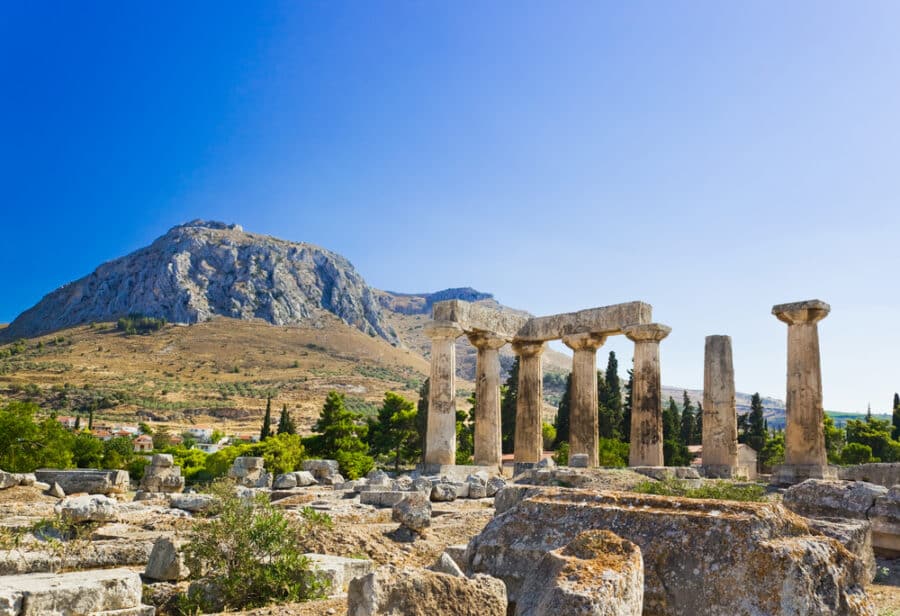
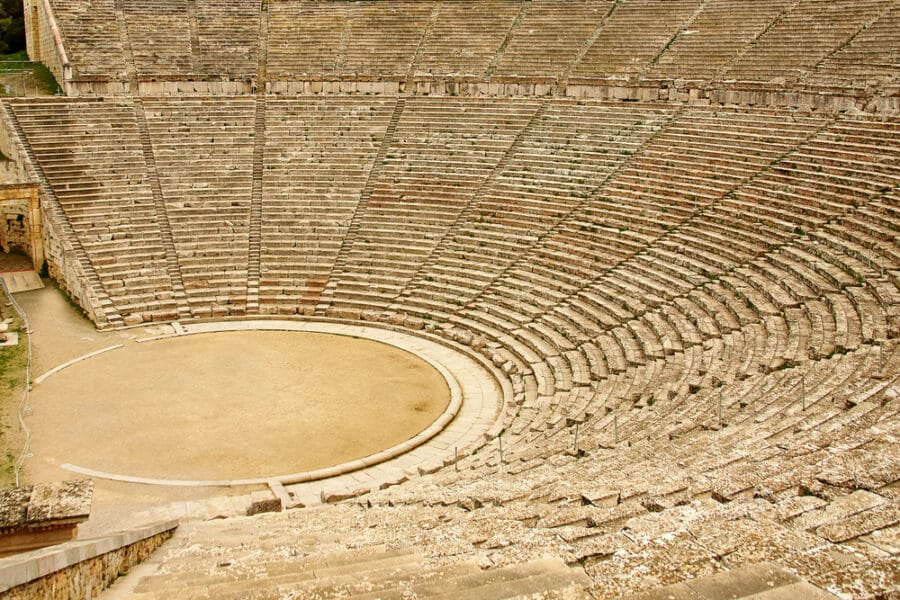
Excellent – as usual